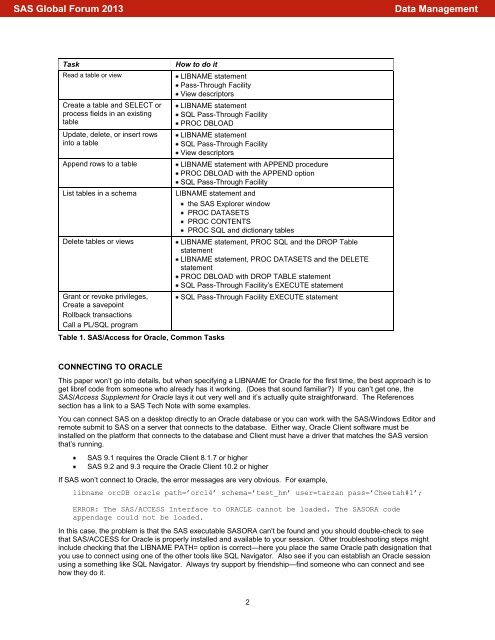072-2013: SAS-Oracle Options and Efficiency: What You Don't Know ...
072-2013: SAS-Oracle Options and Efficiency: What You Don't Know ...
072-2013: SAS-Oracle Options and Efficiency: What You Don't Know ...
You also want an ePaper? Increase the reach of your titles
YUMPU automatically turns print PDFs into web optimized ePapers that Google loves.
<strong>SAS</strong> Global Forum <strong>2013</strong><br />
Data Management<br />
Task<br />
Read a table or view<br />
Create a table <strong>and</strong> SELECT or<br />
process fields in an existing<br />
table<br />
Update, delete, or insert rows<br />
into a table<br />
Append rows to a table<br />
List tables in a schema<br />
Delete tables or views<br />
Grant or revoke privileges,<br />
Create a savepoint<br />
Rollback transactions<br />
Call a PL/SQL program<br />
How to do it<br />
LIBNAME statement<br />
Pass-Through Facility<br />
View descriptors<br />
LIBNAME statement<br />
SQL Pass-Through Facility<br />
PROC DBLOAD<br />
LIBNAME statement<br />
SQL Pass-Through Facility<br />
View descriptors<br />
Table 1. <strong>SAS</strong>/Access for <strong>Oracle</strong>, Common Tasks<br />
LIBNAME statement with APPEND procedure<br />
PROC DBLOAD with the APPEND option<br />
SQL Pass-Through Facility<br />
LIBNAME statement <strong>and</strong><br />
the <strong>SAS</strong> Explorer window<br />
PROC DATASETS<br />
PROC CONTENTS<br />
PROC SQL <strong>and</strong> dictionary tables<br />
LIBNAME statement, PROC SQL <strong>and</strong> the DROP Table<br />
statement<br />
LIBNAME statement, PROC DATASETS <strong>and</strong> the DELETE<br />
statement<br />
PROC DBLOAD with DROP TABLE statement<br />
SQL Pass-Through Facility’s EXECUTE statement<br />
SQL Pass-Through Facility EXECUTE statement<br />
CONNECTING TO ORACLE<br />
This paper won’t go into details, but when specifying a LIBNAME for <strong>Oracle</strong> for the first time, the best approach is to<br />
get libref code from someone who already has it working. (Does that sound familiar?) If you can’t get one, the<br />
<strong>SAS</strong>/Access Supplement for <strong>Oracle</strong> lays it out very well <strong>and</strong> it’s actually quite straightforward. The References<br />
section has a link to a <strong>SAS</strong> Tech Note with some examples.<br />
<strong>You</strong> can connect <strong>SAS</strong> on a desktop directly to an <strong>Oracle</strong> database or you can work with the <strong>SAS</strong>/Windows Editor <strong>and</strong><br />
remote submit to <strong>SAS</strong> on a server that connects to the database. Either way, <strong>Oracle</strong> Client software must be<br />
installed on the platform that connects to the database <strong>and</strong> Client must have a driver that matches the <strong>SAS</strong> version<br />
that’s running.<br />
<strong>SAS</strong> 9.1 requires the <strong>Oracle</strong> Client 8.1.7 or higher<br />
<strong>SAS</strong> 9.2 <strong>and</strong> 9.3 require the <strong>Oracle</strong> Client 10.2 or higher<br />
If <strong>SAS</strong> won’t connect to <strong>Oracle</strong>, the error messages are very obvious. For example,<br />
libname orcDB oracle path=’orcl4’ schema=’test_hm’ user=tarzan pass=’Cheetah#1’;<br />
ERROR: The <strong>SAS</strong>/ACCESS Interface to ORACLE cannot be loaded. The <strong>SAS</strong>ORA code<br />
appendage could not be loaded.<br />
In this case, the problem is that the <strong>SAS</strong> executable <strong>SAS</strong>ORA can’t be found <strong>and</strong> you should double-check to see<br />
that <strong>SAS</strong>/ACCESS for <strong>Oracle</strong> is properly installed <strong>and</strong> available to your session. Other troubleshooting steps might<br />
include checking that the LIBNAME PATH= option is correct—here you place the same <strong>Oracle</strong> path designation that<br />
you use to connect using one of the other tools like SQL Navigator. Also see if you can establish an <strong>Oracle</strong> session<br />
using a something like SQL Navigator. Always try support by friendship—find someone who can connect <strong>and</strong> see<br />
how they do it.<br />
2
















